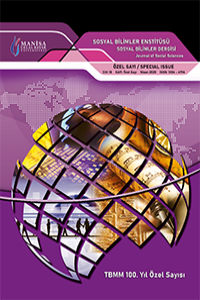Döviz Kuru Oynaklığı ve Karşılaştırmalı Faiz Oranları: Türkiye'de Sermaye Akışları ve Yerleşiklerin Dolarizasyon Eğilimlerini Belirleyen Faktörler
Öz
Bu çalışmada, Türkiye'de döviz kurunda meydana gelen oynaklık şoklarının, yerleşiklerin dolarizasyon eğilimi ve sermaye akışları üzerinde yarattığı etkiler ele alınmıştır. Döviz kurlarına dair oynaklık serileri, EGARCH modeli kullanılarak türetilmiştir. Döviz kurlarındaki oynaklığın sermaye akımları ve dolarizasyona etkilerinin, ayrı hem uzun hem de kısa vadede modellenmesi amacıyla, sınırlandırılmamış hata düzeltme süreci ile yürütülen ARDL yöntemi kullanılmıştır. Ayrıca, faiz politikalarındaki değişimlerin tespit edilmesi amacıyla, ilgili yabancı para birimlerinin faiz oranları da kurulan modellere eklenmiştir. Elde edilen bulgulara göre, dolarizasyon eğilimi ve sermaye akışları üzerinde, döviz kuru oynaklığının etkileri hem uzun hem de kısa vadede oldukça sınırlıdır. Faiz politikalarının ise ilgili değişkenler üzerinde kısa vadede oldukça güçlü bir etkiye sahip olduğu gözlenmektedir. Uzun vadede bu ilişkinin kuvveti daha da artmaktadır. Döviz kuru oynaklığının yüksek seviyelerde seyrettiği dönemlerde dahi, karşılaştırmalı faiz oranlarının dolarizasyon ve sermaye akışları üzerinde, döviz kuru oynaklığına oranla çok daha etkili olması, yerleşiklerin ve yatırımcıların parasal kararlarında büyük ölçüde dürtüsel davranmadığına işaret etmektedir.
Anahtar Kelimeler
Kaynakça
- Bahmani-Oskooee, M., Halicioglu, F., & Mohammadian, A. (2018). On the asymmetric effects of exchange rate changes on domestic production in Turkey. Economic Change and Restructuring, 51(2), 97–112.
- Clarida, R., & Gali, J. (1994). Sources of real exchange-rate fluctuations: How important are nominal shocks? 41, 1–56. Elsevier.
- Dinçer, H., Hacıoğlu, Ü., & Yüksel, S. (2018). Determining Influencing Factors of Currency Exchange Rate for Decision Making in Global Economy Using MARS Method. In Geopolitics and Strategic Management in the Global Economy (pp. 261–273). IGI Global.
- Farrant, K., & Peersman, G. (2006). Is the exchange rate a shock absorber or a source of shocks? New empirical evidence. Journal of Money, Credit, and Banking, 38(4), 939–961.
- Lastrapes, W. D. (1992). Sources of fluctuations in real and nominal exchange rates. The Review of Economics and Statistics, 74(3), 530–539.
- Lay, S. H., Kakinaka, M., & Kotani, K. (2012). Exchange rate movements in a dollarized economy: The case of Cambodia. ASEAN Economic Bulletin, 65–78.
- Mengesha, L. G., & Holmes, M. J. (2013). Does Dollarization Alleviate or Aggravate Exchange Rate Volatility? Journal of Economic Development, 38(2), 99.
- Neanidis, K. C., & Savva, C. S. (2009). Financial dollarization: Short-run determinants in transition economies. Journal of Banking & Finance, 33(10), 1860–1873.
- Pesaran, M. H., Shin, Y., & Smith, R. J. (2001). Bounds testing approaches to the analysis of level relationships. Journal of Applied Econometrics, 16(3), 289–326.
- Rossi, M. M., & Leigh, M. D. (2002). Exchange rate pass-through in Turkey. International Monetary Fund.
- Shin, Y., Yu, B., & Greenwood-Nimmo, M. (2014). Modelling asymmetric cointegration and dynamic multipliers in a nonlinear ARDL framework. In Festschrift in honor of Peter Schmidt (pp. 281–314). Springer.
- TCMB - Financial Accounts Report. (n.d.). Retrieved May 26, 2019.
Exchange Rate Volatility and Comparative Interest Rates: The Determinants of Capital Flows and Resident Dollarization in Turkey
Öz
In this study, the effects of the volatility shocks in the exchange rate on the resident dollarization and the net capital flows are discussed. The volatility of the exchange rate is derived using EGARCH model. ARDL method is used to model the effects of foreign exchange rate volatility on capital flows and dollarization in the long and short term. Additionally, the interest rate series of the relevant foreign currencies have been added to the model to represent the influence of the changes in the interest rate policies in this context. Findings indicate that, in terms of influencing capital flows and resident dollarization, interest rate policies have a significant effect in the short-run while having an even stronger effect in the long run. Additionally, exchange rate shocks have been found to have a limited effect on capital outflows and resident dollarization. Results suggest that the decision making process of investors and residents is not impulsive and even during the periods of excessive exchange rate volatility, the capital outflows and the resident dollarization are significantly more affected by interest rate changes than exchange rate shocks.
Anahtar Kelimeler
Kaynakça
- Bahmani-Oskooee, M., Halicioglu, F., & Mohammadian, A. (2018). On the asymmetric effects of exchange rate changes on domestic production in Turkey. Economic Change and Restructuring, 51(2), 97–112.
- Clarida, R., & Gali, J. (1994). Sources of real exchange-rate fluctuations: How important are nominal shocks? 41, 1–56. Elsevier.
- Dinçer, H., Hacıoğlu, Ü., & Yüksel, S. (2018). Determining Influencing Factors of Currency Exchange Rate for Decision Making in Global Economy Using MARS Method. In Geopolitics and Strategic Management in the Global Economy (pp. 261–273). IGI Global.
- Farrant, K., & Peersman, G. (2006). Is the exchange rate a shock absorber or a source of shocks? New empirical evidence. Journal of Money, Credit, and Banking, 38(4), 939–961.
- Lastrapes, W. D. (1992). Sources of fluctuations in real and nominal exchange rates. The Review of Economics and Statistics, 74(3), 530–539.
- Lay, S. H., Kakinaka, M., & Kotani, K. (2012). Exchange rate movements in a dollarized economy: The case of Cambodia. ASEAN Economic Bulletin, 65–78.
- Mengesha, L. G., & Holmes, M. J. (2013). Does Dollarization Alleviate or Aggravate Exchange Rate Volatility? Journal of Economic Development, 38(2), 99.
- Neanidis, K. C., & Savva, C. S. (2009). Financial dollarization: Short-run determinants in transition economies. Journal of Banking & Finance, 33(10), 1860–1873.
- Pesaran, M. H., Shin, Y., & Smith, R. J. (2001). Bounds testing approaches to the analysis of level relationships. Journal of Applied Econometrics, 16(3), 289–326.
- Rossi, M. M., & Leigh, M. D. (2002). Exchange rate pass-through in Turkey. International Monetary Fund.
- Shin, Y., Yu, B., & Greenwood-Nimmo, M. (2014). Modelling asymmetric cointegration and dynamic multipliers in a nonlinear ARDL framework. In Festschrift in honor of Peter Schmidt (pp. 281–314). Springer.
- TCMB - Financial Accounts Report. (n.d.). Retrieved May 26, 2019.
Ayrıntılar
| Birincil Dil | İngilizce |
|---|---|
| Bölüm | Makaleler |
| Yazarlar | |
| Yayımlanma Tarihi | 28 Nisan 2020 |
| Yayımlandığı Sayı | Yıl 2020 TBMM 100. Yıl Özel Sayısı |


